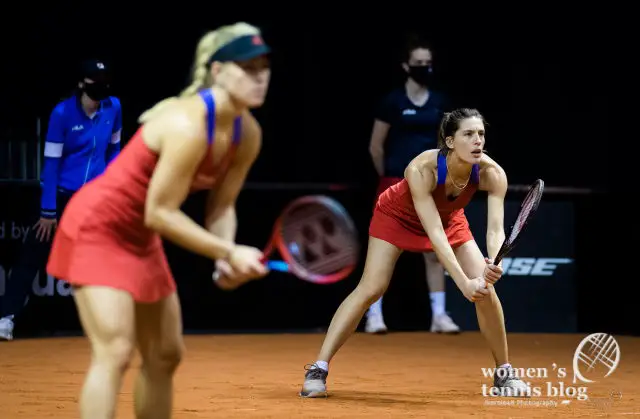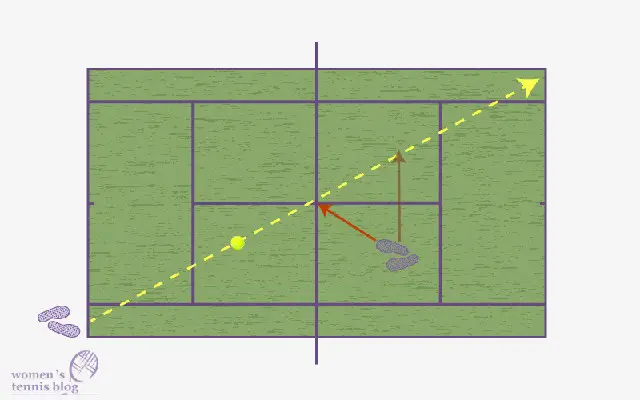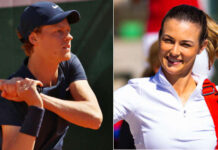This article is written by James from MindtheRacket.com.
So what you’re going to do first is crack an egg and pour it into a bowl and…
Ok… bad joke, but had to be done.
Now we’ve got our terrible humor out the way, it’s important to distinguish what exactly we mean by poaching and the difficulties that you might run into when trying it out.
If you’ve been focusing on your singles game for a while, taking your tactics and applying them in a doubles match can prove difficult. Singles and doubles are so far removed from each other that they’re almost entirely different sports.
Firstly, the court is bigger. The tramlines add further width to the layout.
Secondly, it becomes a team game and you NEED to discuss your next move with your partner between games and sometimes even between individual points.
Thirdly, there are things you can try in doubles that prove near impossible in singles… One of these things is poaching when up at the net.

What is poaching?
In doubles, if you’re not serving but your partner is, you’ll be stationed up at the net. Your mission here is to cut off any shots that come in your direction with a nice powerful volley back over the net. Easy enough, right?
Well, what if we told you that you can also cut across onto your partner’s side of the court to surprise your opponents? Yep, this is an entirely legitimate play in doubles and it’s what is known as poaching the ball.
The aim is to redirect a shot that was meant for your partner with a surprise volley to catch your opponent off-guard. With any luck, they won’t see it coming and will be left powerlessly scrambling to try and return a volley that they weren’t expecting.
You’re looking to shorten points with this play. If you’re finding that extended rallies are not going your way in the match, poaching is a brilliant way to inject some variety and keep your rivals guessing from point to point.
When should you try poaching?
If your partner has served a low dipping ball that leaves the returner unable to do much more than flick the ball back cross-court to keep it in play, this presents the opportune moment to poach across and kill the rally before it’s even got going. Poaching right after a serve is a brilliant tactical play.
High cross-court shots will allow you to pick volleys off with ease and you should be looking for moments where you can make your presence at the net felt, especially if your partner is struggling in the baseline exchanges.
Analyze what your opponent’s patterns of play are. If they’re favoring long-baseline cross-court rallies, this will allow you more opportunities to try for that surprise cut-off winner. If they’re powering shots straight at you at the net, hold firm and show no weakness there if you can. This will hopefully tempt them into falling back on easier cross-court shots.

When NOT to try poaching!
If you haven’t even discussed the possibility that you may try and poach in the next point, you’ve already made your first mistake. Doubles is a team effort and if your partner has no clue what you’re planning, they’re not going to be able to help set you up for the put-away.
If you’ve telegraphed to your opponents that you’re about to poach, DO NOT POACH! This shouldn’t really need to be said but poaching is a surprise play and if your rivals know what you’re about to try, they’re going to be moving into place to slap a winner into your abandoned side of the court. Keep your movement light and natural right up until the moment that you step across.
Also, don’t rely on poaching as a regular play in rallies! The entire point of poaching is the element of shock and if you’re utilizing poaching moves in every rally, your opponents are going to see right through you. They’ll start reading you like a book and before long, they’ll be EXPECTING you to poach.
An expected poach is a BAD poach.
Poaching tips
Moving diagonally
When poaching, it’s important to move diagonally forward to reach the ball. This in turn will allow you to reach the ball quicker and cut it off.
Let’s take an example.

Your opponent has hit a shot cross-court from their baseline. You’re situated in the center of your service box. To reach the ball quicker, move diagonally forward towards the path of the ball.
If you did not move diagonally forward, and instead directly to your right, you would need to travel a further to reach the ball. This in turn allows you to reach the ball faster and stand a better chance of winning the point.
Experiment
So this is a little bit of fun and something that can help you enjoy the act of poaching.
The fake poach! The entire point of poaching is to mess with your opponents’ heads in an effort to befuddle them further into making rookie mistakes. So try taking a quick step across the court before stepping back into your side.
With any luck, this will tempt them into going for a shot to your side of the court and you’ll be able to easily volley away the winner from your usual position.
Your mindset is a major aspect of poaching as well. Poaching demonstrates confidence in your ability to finish points with an immediate display of powerful authority. Try to remain upbeat and don’t let your belief in yourself waver if you miss a few poaching attempts. Because you will miss a few.
And that’s OK!
Final tip
Watch professional doubles matches.
We’re serious. So much of tennis advertisement is focused on singles matches but doubles players are just as brilliantly fantastic at their craft and often get overlooked by their singles equivalents.
If you’re playing more and more doubles, watching professional doubles matches will enable you to pick up on specific tactics here and there, and watching these athletes poach at the net is an art form all by itself.
It’s well worth your time and at the very least, will motivate you to get back out there.
To summarize
And that’s the poach!
It’s a lot of fun when pulled off successfully and is immensely frustrating when it goes wrong but that’s the beauty of trying to find the perfect poaching play.
Remember the three key elements of poaching: Surprise. Surprise. SURPRISE! If you keep those things in mind, you’ll be well on your way to mastering the poach.
There you have it. You’re ready to get back out there and we’re ready to go and write our next article about frying when up at the net…
Visit our Tennis Tips page for a lot more articles meant to improve your tennis game, both singles and doubles.







